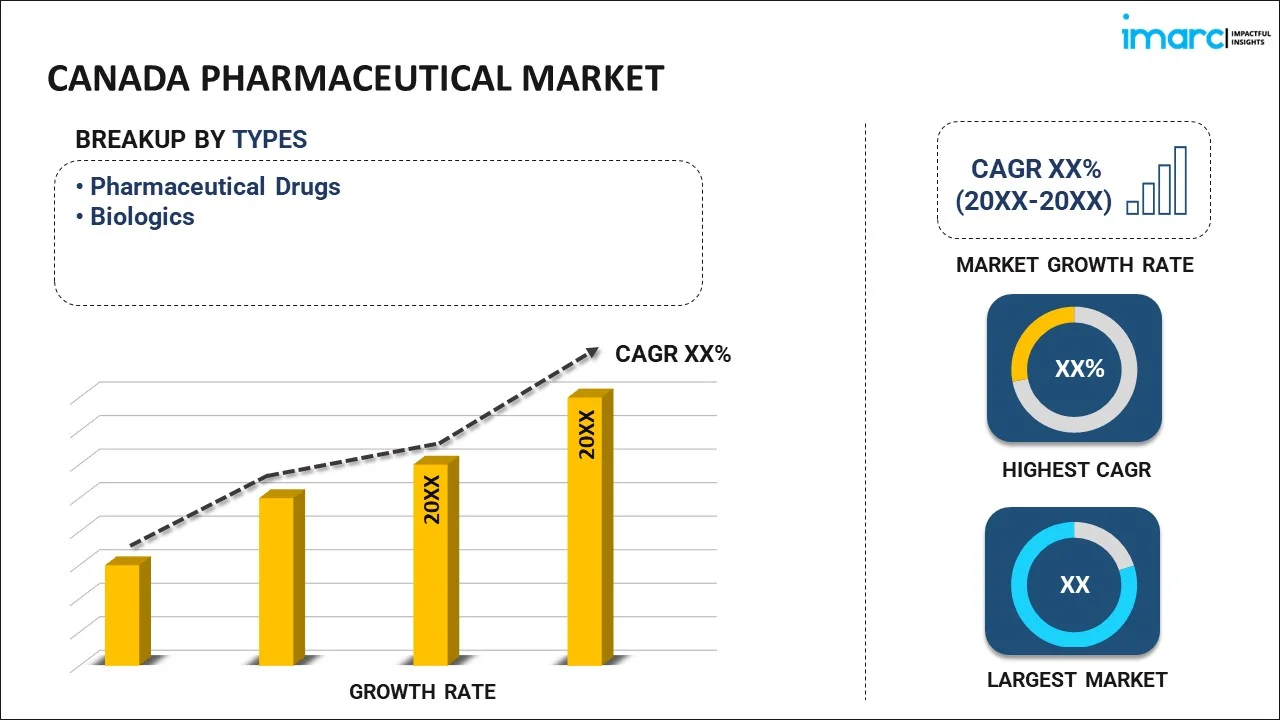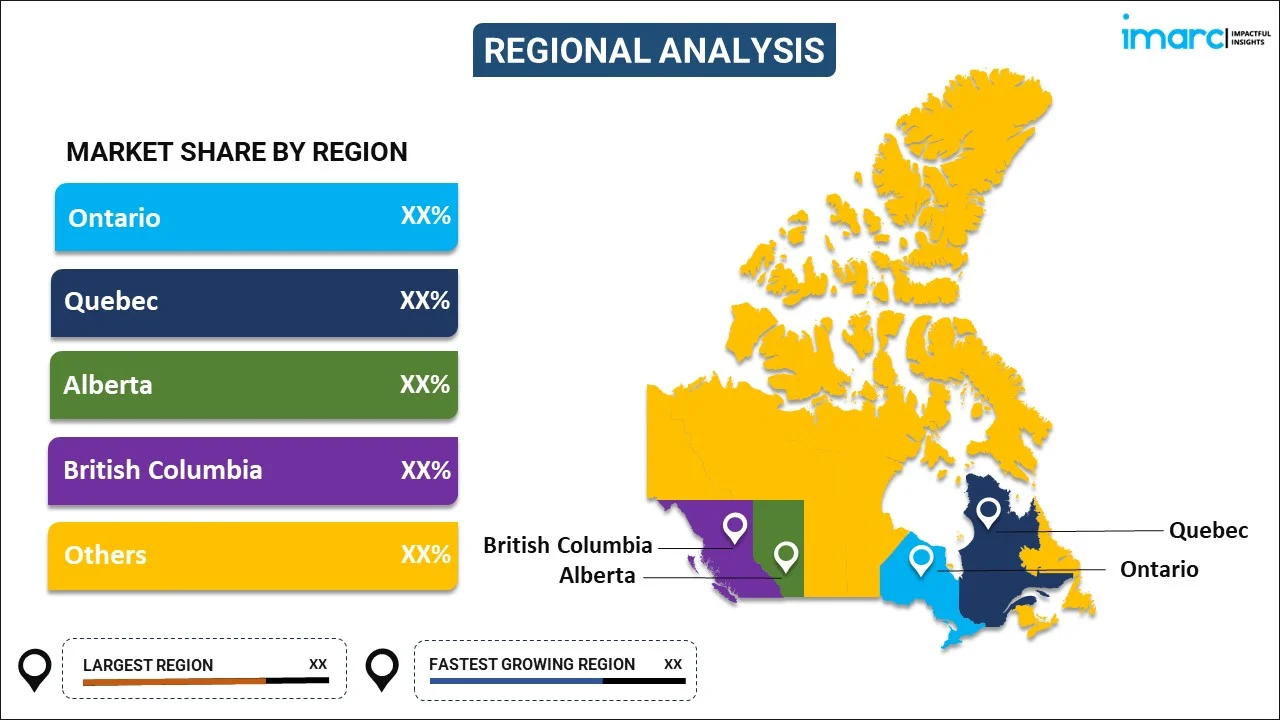
Canada Pharmaceutical Market Report by Type (Pharmaceutical Drugs, Biologics), Nature (Organic, Conventional), and Region 2024-2032
Canada Pharmaceutical Market Overview:
The Canada pharmaceutical market is projected to exhibit a growth rate (CAGR) of 6.10% during 2024-2032. The market is propelled by the aging population and the rising prevalence of chronic diseases, government support and healthcare policies, and robust pharmaceutical research and development (R&D) sector, supported by world-class research institutions.
|
Report Attribute
|
Key Statistics
|
|---|---|
|
Base Year
|
2023 |
|
Forecast Years
|
2024-2032
|
|
Historical Years
|
2018-2023
|
| Market Growth Rate (2024-2032) | 6.10% |
Canada Pharmaceutical Market Trends:
Increasing Aging Population and Chronic Diseases
The Canadian pharmaceutical market is primarily driven by the country's aging population and the increased prevalence of chronic diseases. According to Statistics Canada, more than 861,000 persons aged 85 and older were counted in the 2021 Census, more than double the figure from the 2001 Census. The population aged 85 and older is one of the fastest-growing age groups, rising 12% from 2016. Currently, 2.3% of the population is aged 85 and more. As the population ages, the need for pharmaceuticals and healthcare services rises. Chronic disorders such as cardiovascular disease, diabetes, arthritis, and Alzheimer's disease are increasingly common in the elderly, necessitating continuing medication and therapy. This demographic shift creates a sustained demand for pharmaceuticals, including both prescription and over-the-counter drugs. Furthermore, the increasing incidence of chronic diseases among younger populations due to lifestyle factors such as poor diet, lack of exercise, and stress further fuels the market. The prevalence of chronic conditions increased from 2015 to 2021, including high blood pressure (16.9% to 17.7%), heart disease (4.4% to 4.9%) and obesity (26.1% to 29.2%).However, the lung cancer incidence rate among males declined from 72.2 per 100,000 people in 2015 to 62.5 per 100,000 in 2021.
Government Policies
Government assistance and healthcare policy have a considerable impact on the Canadian pharmaceutical business. The Canadian government has implemented a number of steps to ensure that pharmaceuticals are both accessible and affordable to its inhabitants. For instance, the Patented Medicine Prices Review Board (PMPRB) protects and informs Canadian consumers by reviewing the prices of patented medicines sold in Canada, and by reporting on pharmaceutical trends. Furthermore, the public healthcare system, which covers a large proportion of the population, promotes the use of pharmaceutical items. The government also invests in healthcare infrastructure and research, creating an atmosphere that promotes pharmaceutical innovation and growth. Initiatives aimed at boosting generic drug use and biosimilars also contribute to market dynamics because they provide cost-effective alternatives to branded medications.
Canada Pharmaceutical Market News:
- August 2023: The Patented Medicine Prices Review Board (PMPRB) published the 7th edition of its annual Meds Entry Watch report. The analysis finds that the number of new medicines launched in Canada is higher than the median for Organization for Economic Co-operation and Development (OECD) countries and falls below the median of the eleven PMPRB comparators. Most new medicines come to market with high treatment costs, and specialty medicines such as biologic, orphan, and cancer treatments continue to make up a growing share of the new drug landscape.
- June 2024: Since November 2023, Canada’s drug regulator, Health Canada, has approved no fewer than five biosimilars for the treatment of deep vein thrombosis (DVT), cancer, plaque psoriasis, psoriatic arthritis, Crohn’s disease, ulcerative colitis and several serious retinal diseases, such as wet age-related macular degeneration. By end of March 2024, Health Canada has approved 59 biosimilars within the product classes of human growth hormone, granulocyte colony-stimulating factor (G-CSF), insulin, monoclonal antibodies and tumor necrosis factor (TNF)-inhibitor, for use in Canada.
Canada Pharmaceutical Market Segmentation:
IMARC Group provides an analysis of the key trends in each segment of the market, along with forecasts at the country level for 2024-2032. Our report has categorized the market based on type and nature.
Type Insights:

- Pharmaceutical Drugs
- Cardiovascular Drugs
- Dermatology Drugs
- Gastrointestinal Drugs
- Genito-Urinary Drugs
- Hematology Drugs
- Anti-Infective Drugs
- Metabolic Disorder Drugs
- Musculoskeletal Disorder Drugs
- Central Nervous System Drugs
- Oncology Drugs
- Ophthalmology Drugs
- Respiratory Diseases Drugs
- Biologics
- Monoclonal Antibodies (MAbS)
- Therapeutic Proteins
- Vaccines
The report has provided a detailed breakup and analysis of the market based on the type. This includes pharmaceutical drugs (cardiovascular drugs, dermatology drugs, gastrointestinal drugs, genito-urinary drugs, hematology drugs, anti-infective drugs, metabolic disorder drugs, musculoskeletal disorder drugs, central nervous system drugs, oncology drugs, ophthalmology drugs, and respiratory diseases drugs) and biologics (monoclonal antibodies (MAbS), therapeutic proteins, and vaccines).
Nature Insights:
- Organic
- Conventional
A detailed breakup and analysis of the market based on the nature have also been provided in the report. This includes organic and conventional.
Regional Insights:

- Ontario
- Quebec
- Alberta
- British Columbia
- Others
The report has also provided a comprehensive analysis of all the major regional markets, which include Ontario, Quebec, Alberta, British Columbia, and others.
Competitive Landscape:
The market research report has also provided a comprehensive analysis of the competitive landscape in the market. Competitive analysis such as market structure, key player positioning, top winning strategies, competitive dashboard, and company evaluation quadrant has been covered in the report. Also, detailed profiles of all major companies have been provided.
Canada Pharmaceutical Market Report Coverage:
| Report Features | Details |
|---|---|
| Base Year of the Analysis | 2023 |
| Historical Period | 2018-2023 |
| Forecast Period | 2024-2032 |
| Units | US$ Billion |
| Scope of the Report | Exploration of Historical Trends and Market Outlook, Industry Catalysts and Challenges, Segment-Wise Historical and Future Market Assessment:
|
| Types Covered |
|
| Natures Covered | Organic, Conventional |
| Regions Covered | Ontario, Quebec, Alberta, British Columbia, Others |
| Customization Scope | 10% Free Customization |
| Post-Sale Analyst Support | 10-12 Weeks |
| Delivery Format | PDF and Excel through Email (We can also provide the editable version of the report in PPT/Word format on special request) |
Key Questions Answered in This Report:
- How has the Canada pharmaceutical market performed so far and how will it perform in the coming years?
- What has been the impact of COVID-19 on the Canada pharmaceutical market?
- What is the breakup of the Canada pharmaceutical market on the basis of type?
- What is the breakup of the Canada pharmaceutical market on the basis of nature?
- What are the various stages in the value chain of the Canada pharmaceutical market?
- What are the key driving factors and challenges in the Canada pharmaceutical?
- What is the structure of the Canada pharmaceutical market and who are the key players?
- What is the degree of competition in the Canada pharmaceutical market?
Key Benefits for Stakeholders:
- IMARC’s industry report offers a comprehensive quantitative analysis of various market segments, historical and current market trends, market forecasts, and dynamics of the Canada pharmaceutical market from 2018-2032.
- The research report provides the latest information on the market drivers, challenges, and opportunities in the Canada pharmaceutical market.
- Porter's five forces analysis assist stakeholders in assessing the impact of new entrants, competitive rivalry, supplier power, buyer power, and the threat of substitution. It helps stakeholders to analyze the level of competition within the Canada pharmaceutical industry and its attractiveness.
- Competitive landscape allows stakeholders to understand their competitive environment and provides an insight into the current positions of key players in the market.
Need more help?
- Speak to our experienced analysts for insights on the current market scenarios.
- Include additional segments and countries to customize the report as per your requirement.
- Gain an unparalleled competitive advantage in your domain by understanding how to utilize the report and positively impacting your operations and revenue.
- For further assistance, please connect with our analysts.
 Inquire Before Buying
Inquire Before Buying
 Speak to an Analyst
Speak to an Analyst
 Request Brochure
Request Brochure
 Request Customization
Request Customization




.webp)




.webp)












